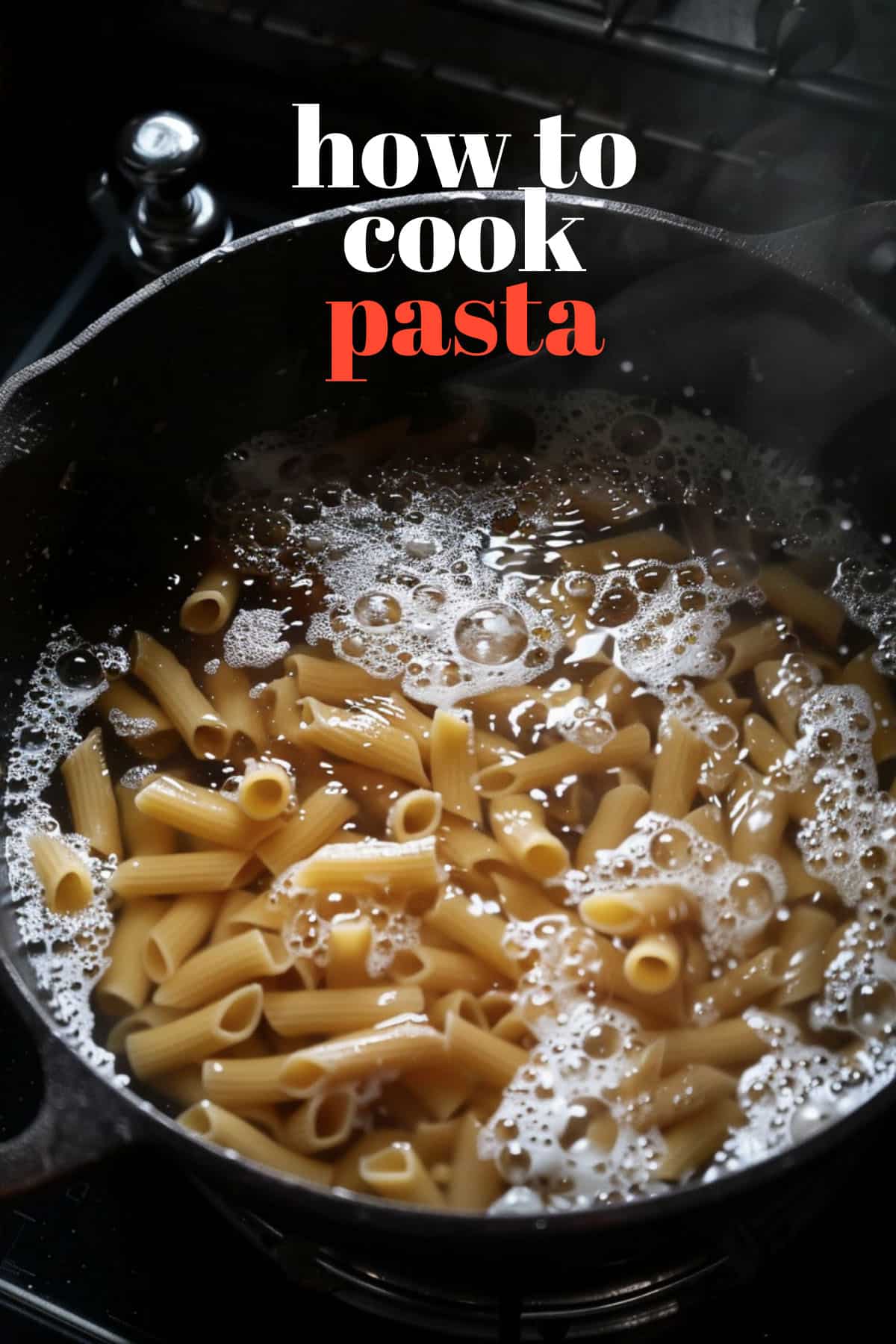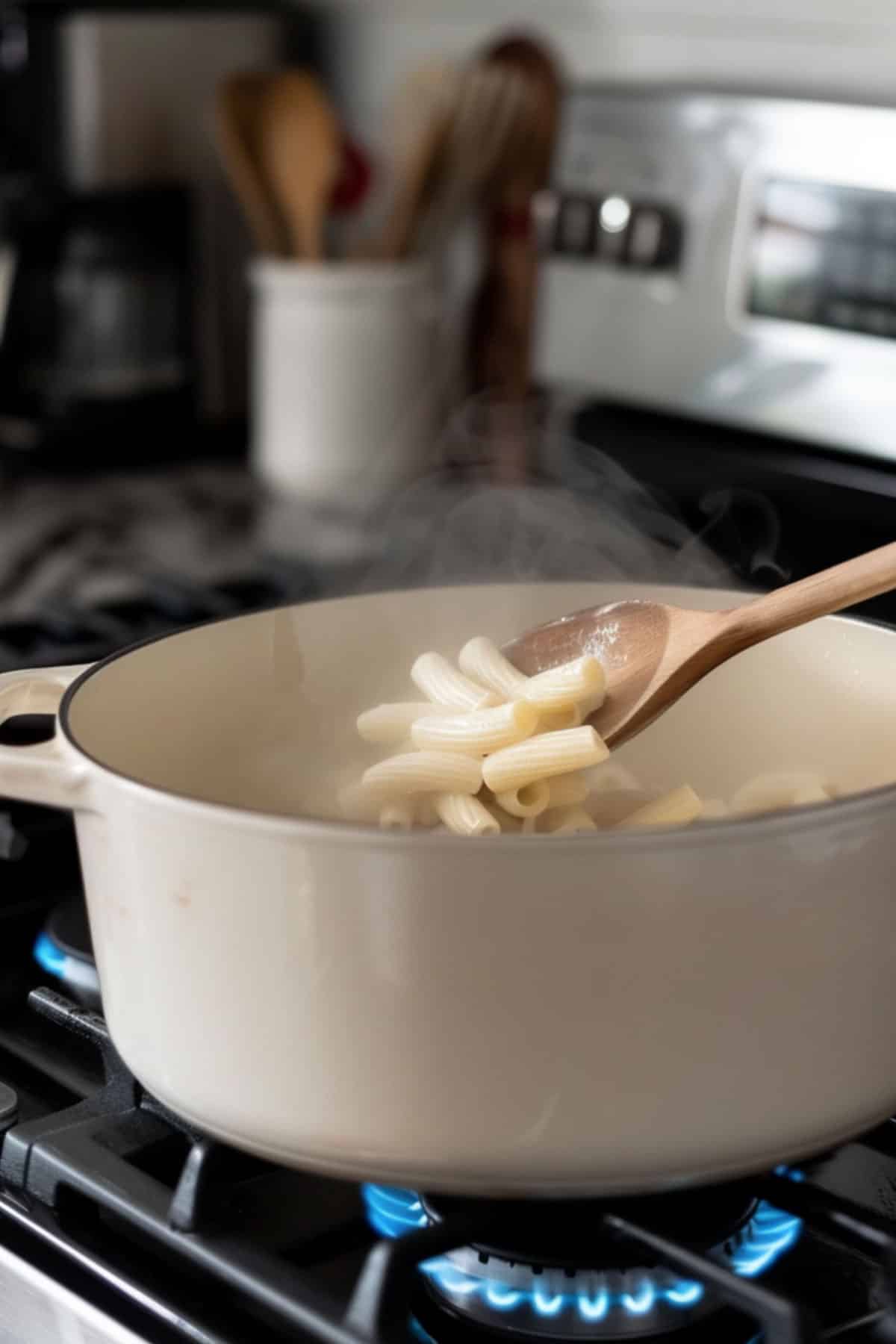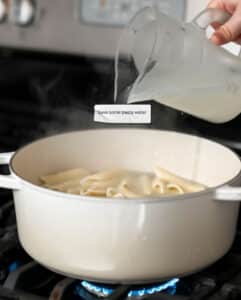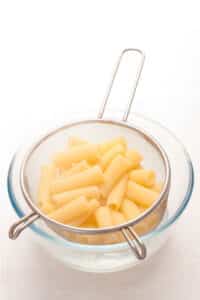How to cook pasta seems like it should be easy, but we've all been there – staring down a disappointing pile of pasta, wondering where it all went wrong. Turns out, even the simplest recipes can be deceptive! Should you add salt? Is a rinse really necessary? But don't give up – I'm here to share the tricks that guarantee perfect pasta. Get ready to say goodbye to mushy mishaps and hello to restaurant-quality noodles at home!

How to Cook Pasta Perfectly
Step 1: Choosing Your Vessel Wisely
- The Importance of Size: A large pot Dutch oven (3-4 quarts of water per pound of pasta) is essential for several reasons:
- Freedom of Movement: Pasta needs space to twirl without clumping, ensuring even cooking. A cramped pot leads to unevenly cooked, sticky noodles.
- Water Temp Stability: More water means the temperature won't drop drastically when the pasta is added, allowing for a quicker return to a boil.
- Reduced Boil-Overs: Ample water volume minimizes the chances of starchy foam-overs.
- Freedom of Movement: Pasta needs space to twirl without clumping, ensuring even cooking. A cramped pot leads to unevenly cooked, sticky noodles.
- Water Temp Stability: More water means the temperature won't drop drastically when the pasta is added, allowing for a quicker return to a boil.
- Reduced Boil-Overs: Ample water volume minimizes the chances of starchy foam-overs.
- Material Matters: Beyond Size
- Heavy-Bottomed is Best: Pots made from materials like cast iron or stainless steel with a thick base retain heat better than thin-walled pots. This means the water comes back to a boil faster after the pasta is added.
- Tall Sides for Long Pasta: When cooking spaghetti, linguine, or other long noodles, a pot with taller sides prevents them from bending and breaking as you submerge them.
- Beyond Brand Specificity: While a 5-quart Dutch oven is an excellent choice, it's important to note that other heavy-bottomed pots will work just as well. The key is focusing on the qualities of the pot (size, material ) rather than the specific brand.

Step 2: Always Salt Your Pasta Water
- The Ocean Analogy: A Powerful Reminder Comparing the ideal saltiness to seawater is both memorable and informative. It drives home that salting should be generous, not just an afterthought.
- Flavor Infusion: It's Not Just the Sauce Salting the pasta water is the only opportunity to season the pasta itself from the inside out. Well-seasoned pasta creates a foundation of flavor that carries through the entire dish.
- Salt Specifications and Options
- Quantity: The guideline of 1-1.5 tablespoons of salt per pound of pasta is a great starting point.
- Salt Type: While coarse sea salt or kosher salt are ideal, regular table salt can be used. Just remember to adjust the amount slightly, as table salt is generally saltier due to its smaller grain size.
- Timing: Adding salt after the water boils ensures it dissolves completely, avoiding undissolved salt grains sticking to the pasta.

Step 3: Stir Often to Prevent Sticking – Do NOT Add Oil!
- Why Stirring is Your Friend
- Initial Stirs are Key: Frequent stirring in the first few minutes after adding the pasta helps separate the noodles and prevents them from clumping as the starches are released.
- Gentle but Effective: The goal is to keep the pasta moving without breaking or tangling the strands.
- The Oil Debate: Why it's a Myth
- Barrier to Deliciousness: Oil creates a slick coating on the pasta, which actually prevents sauce from adhering properly. The goal is a unified dish where sauce and pasta are beautifully integrated.
- Stirring is the Solution: A good stir is far more effective in preventing sticking than adding oil to the water.

Step 4: Cook to Al Dente
- Al Dente: Texture is Everything
- The Perfect Bite: Al dente pasta should be firm to the tooth but not hard or crunchy, with a slight resistance when you bite into it. It should offer a satisfying chew without being overly soft or mushy.
- Taste Test Triumph: Don't Rely Solely on Time
- Package Instructions are a Guide: The timing on pasta boxes is a starting point, but factors like brand, pasta shape, and even your stovetop can impact the perfect cooking time.
- Trust Your Tastebuds: Tasting a noodle a minute or two before the suggested cook time is the best way to ensure that perfect al dente texture.
- Pasta Variety Guidelines: Know Your Noodles
- **Dry Pasta: ** Ranges like "8-10 minutes" are helpful, reminding cooks to test doneness throughout for various shapes.
- Fresh Pasta: The emphasis on its very quick cook time (1-3 minutes) highlights the major difference between fresh and dried pasta.
- Stuffed Pasta/Gnocchi: Mentioning that these float when done is a great visual cue.
- Baked Pasta: The importance of undercooking slightly for baked dishes is key, preventing them from becoming overcooked in the oven.

Step 5: Always Reserve Pasta Water Prior to Draining
- Liquid Gold: It's Not Just Water Anymore!
- Starch = Sauce Magic: The starchiness of pasta water helps sauces thicken, emulsify, and achieve that silky, rich texture.
- Flavor Booster: Pasta water carries a hint of salt and some of the pasta's flavor, adding an extra dimension to your sauce.
- Quantity Guidance: While 1 cup is a good rule, emphasize that even if the full amount isn't needed, it's better to have a little extra on hand than none at all.

Step 6: Drain But Skip the Rinse
Carefully drain your pasta using a colander in the sink. Rinsing washes away the starch that helps sauce cling to your noodles. Aim for an al dente texture: firm with a slight bite. Check for a small white dot in the middle of a noodle – that's your perfect doneness cue!

Related articles:
- How to Fix Overcooked Pasta
- How to Fix Undercooked Pasta
- How to Store and Use Leftover Pasta
- Why is my Pasta Chewy
- How to Stop Pasta from Sticking Overnight
- How Long is Cooked Spaghetti is Good in the Fridge
Key Pasta Principles
Equip yourself with the knowledge to tackle any pasta dish with confidence! Remember, practice makes perfect (and delicious!), so get out there and experiment with different types of pasta and sauces.
1. Water, Salt, Pasta: It's All About the Ratio
- Don't Skimp on Water: Imagine your pasta as a bunch of tiny swimmers. They need enough space to move around freely, or they'll bump into each other and end up stuck together in a clumpy mess. That's why using a large pot with plenty of water is crucial. Here's a good rule of thumb: 4-6 quarts of water for every pound of pasta. This ensures even cooking and prevents sticking for delightfully separated noodles.
- Salty Like the Sea: Okay, maybe not that salty, but don't be afraid of salt! Forget the myth that salt just speeds up boiling. Yes, it does that, but the real magic happens to the flavor of the pasta itself. Salting your water generously seasons the noodles from the inside out, so they're not bland and boring. Think of it like adding a little flavor boost directly to your pasta party! A good starting point is 1 tablespoon of salt per quart of water.
- Pasta Shapes Matter: While we're on the topic of water, keep in mind that different pasta shapes have different cooking times. Thin, delicate noodles like angel hair or spaghetti cook much faster than thick, chunky shapes like penne or rigatoni. This is because the thicker the pasta, the longer it takes for the heat to penetrate the center. We'll explore specific cooking times for various shapes in another lesson, but for now, just remember: thicker shapes generally require more cooking time.
2. The Perfect Boil
- Bubbles are Your Friend: A gentle simmer won't cut it here. You need a rolling boil, a vigorous, rolling motion in the water with big, angry bubbles that can't be easily stirred away. This intense heat ensures the water temperature is high enough to cook the pasta quickly and evenly.
- The Pasta Plunge = Temp Drop: Here's a little science for your next dinner party trick: When you add your room-temperature pasta to the boiling water, it naturally lowers the water temperature. That's why it's important to bring the pot back to a rolling boil as quickly as possible. This ensures consistent cooking for all your precious noodles.
3. The Mystery of "Al Dente"
- It's a Feeling, Not a Time: Sure, the pasta box gives you a time, but that's just a starting point. Al dente, which translates to "to the tooth" in Italian, describes the ideal texture for cooked pasta. It should be firm to the bite, with a slight resistance when you chew it. Think of it like the happy medium between perfectly cooked and still a bit underdone – definitely not mushy or soft all the way through.
- Taste Test Time: Don't rely solely on the package instructions! Package cooking times can vary depending on the brand and the specific type of pasta. That's why it's important to taste test your pasta a minute or two before the recommended time. Fish out a noodle, take a bite, and see if it's reached that delightful al dente state. You can also check for doneness by looking for a tiny white speck in the center of the noodle if you cut it in half. A tiny white dot means it needs a little more time, while no white speck signifies perfect al dente!
4. Tips from a Pasta Pro
- Stir it Up for Separation: Especially in the first few minutes after adding the pasta, give it a good stir occasionally. This helps prevent the noodles from sticking together and clumping at the bottom of the pot.
- The Oil Debate: To Add or Not to Add? You'll hear conflicting advice about adding oil to the water. Honestly, in my experience, a good stir is more effective than oil in preventing sticking. However, some people swear by a drizzle of olive oil to keep the noodles from clumping. If you want to try it, a little goes a long way – too much oil can make your sauce slide right off the pasta later.
- Oops! Overcooked? Don't Panic!: We've all been there – you get caught up in conversation and suddenly your pasta is a little softer than al dente. Don't despair! A quick toss with a bit of sauce can help revive slightly overcooked noodles. The sauce can add a little moisture and help the pasta regain some of its texture.
5. Stop the Cooking
Drainage Do's: Why Timing is Everything
- Overcooked = Mushy Mess: The moment you drain your pasta, you've stopped the cooking process. This may seem obvious, but it's crucial to understand why. Overcooked pasta quickly becomes soft, mushy, and loses that delightful al dente texture you worked so hard for. Immediate draining prevents this pasta tragedy!
- Sticky Situation: If cooked pasta sits in its water for too long, the residual starch starts to work against you. The noodles release more and more starch into the water, making them gummy and prone to sticking together.
The Power of Pasta Water: Your Secret Sauce Weapon
- Thickening Power: The starchy, slightly salty water you cooked your pasta in is liquid gold! A splash or two added to your sauce helps it thicken beautifully. This works because the starches in the water help emulsify the fat and liquid in your sauce, creating a creamy, unified texture.
- Flavor Boost: That pasta water isn't just about texture! Because it's lightly salted and absorbed some of the pasta's flavor, it adds a subtle seasoning boost when mixed into your sauce.
- Stretching Your Sauce: If your sauce seems a bit too thick, a little pasta water is a perfect way to thin it out gently without diluting the flavors.
Important Note: You only need to reserve about a cup or so of pasta water, even for a huge batch. The rest can be drained away!
Extra Tips:
- Colander = Your Friend: A colander or large strainer is the best tool for quickly and safely draining the cooking water.
- Toss, Don't Rinse: Unless you're making a pasta salad, rinsing your cooked pasta is usually unnecessary. Tossing it with your sauce immediately is the best way to prevent sticking. Rinsing removes the starches that help your sauce cling to the noodles.
How to Choose the Perfect Pasta for Your Sauce
Okay, sure, you can throw any old noodle into a sauce and call it dinner. But if you want a truly amazing pasta experience, it's worth getting a little picky about your shapes. Why? Because the right pasta-sauce combo is like a flavor power-up for your dish!
How to Pick the Perfect Pasta Shape
When choosing pasta for a recipe, put on your sauce detective hat: Is it light and delicate? Chunky and flavorful? Rich and hearty? Here's the general rule: the bolder the sauce, the bolder the noodle needs to be! Let's break it down:
Fine Pasta for Light Sauces & Delicate Flavor
Think simple tomato sauces, olive oil and garlic, pesto... these are all about bright, fresh flavors. You don't want a heavy noodle to overpower them! Pair these sauces with:
- Angel hair (capellini): Light as a feather, perfect for the simplest preparations.
- Linguine or spaghetti: Classic strands, versatile enough for anything.
- Casarecce: Looks like a loosely rolled scroll, gives a light sauce more to cling to.
Short Pasta: Perfect for Chunky and Creamy Sauces
When your sauce has bits of veg, meat, or that luscious cheesy texture, you want a pasta that's going to give you a satisfying bite. Look for shapes with all those delicious nooks and crannies to capture every bit of flavor. Try these:
- Rigatoni: Those sturdy tubes are sauce magnets.
- Shellbows: Think mini mac and cheese bowls!
- Cavatappi: Corkscrew-like, so every twist and turn is coated in deliciousness.
Wide Pasta Shapes for Bold, Rich Sauces
We're talking about slow-cooked meat sauces, the thick, luscious ones that have simmered all day. These need a pasta that can stand up to their power, not disappear under all that flavor. Go for:
- Bucatini: Like thick spaghetti with a hole in the center (yes, you can slurp sauce through it!)
- Fettuccine: Wide, satisfying ribbons
- Pappardelle: The king of wide noodles, perfect for twirling up rich sauces.
Try Our Favorite Pasta Dishes
- Cheesecake Factory Tomato Basil Pasta
- Vodka Sauce Pasta Recipe
- Slow Cooked Shredded Beef Ragu Pasta
- Penne Pasta Primavera
- J Alexander Rattlesnake Pasta
- Spicy Miso Carbonara
How to Cook Pasta Perfectly
Pin RecipeEquipments:
- stovetop
Ingredients:
- 1 lb pasta of your choice
- Water
Instructions:
Choosing your Vessel Wisely:
- The Importance of Size: A large pot (3-4 quarts of water per pound of pasta) is essential for several reasons:Freedom of Movement: Pasta needs space to twirl without clumping, ensuring even cooking. A cramped pot leads to unevenly cooked, sticky noodles.Water Temp Stability: More water means the temperature won't drop drastically when the pasta is added, allowing for a quicker return to a boil.Reduced Boil-Overs: Ample water volume minimizes the chances of starchy foam-overs.
- Material Matters: Beyond SizeHeavy-Bottomed is Best: Pots made from materials like cast iron or stainless steel with a thick base retain heat better than thin-walled pots. This means the water comes back to a boil faster after the pasta is added.Tall Sides for Long Pasta: When cooking spaghetti, linguine, or other long noodles, a pot with taller sides prevents them from bending and breaking as you submerge them.
Always Salt your Pasta Water
- The Ocean Analogy: Comparing the ideal saltiness to seawater is both memorable and informative. It drives home that salting should be generous, not just an afterthought.Flavor Infusion: It's Not Just the Sauce Salting the pasta water is the only opportunity to season the pasta itself from the inside out. Well-seasoned pasta creates a foundation of flavor that carries through the entire dish.Salt Specifications and Options:Quantity: The guideline of 1-1.5 tablespoons of salt per pound of pasta is a great starting point.Salt Type: While coarse sea salt or kosher salt are ideal, regular table salt can be used. Just remember to adjust the amount slightly, as table salt is generally saltier due to its smaller grain size.Timing: Adding salt after the water boils ensures it dissolves completely, avoiding undissolved salt grains sticking to the pasta.
Stir Often to Prevent Sticking – Do not Add Oil!
- Why Stirring is Your FriendInitial Stirs are Key: Frequent stirring in the first few minutes after adding the pasta helps separate the noodles and prevents them from clumping as the starches are released.Gentle but Effective: The goal is to keep the pasta moving without breaking or tangling the strands.The Oil Debate: Why it's a MythBarrier to Deliciousness: Oil creates a slick coating on the pasta, which actually prevents sauce from adhering properly. The goal is a unified dish where sauce and pasta are beautifully integrated.Stirring is the Solution: A good stir is far more effective in preventing sticking than adding oil to the water.
Cook to Al Dente:
- The Perfect Bite: Al dente pasta should be firm to the tooth but not hard or crunchy, with a slight resistance when you bite into it. It should offer a satisfying chew without being overly soft or mushy.Don't Rely Solely on TimePackage Instructions are a Guide: The timing on pasta boxes is a starting point, but factors like brand, pasta shape, and even your stovetop can impact the perfect cooking time.Trust Your Tastebuds: Tasting a noodle a minute or two before the suggested cook time is the best way to ensure that perfect al dente texture.Pasta Variety Guidelines: Know Your Noodles**Dry Pasta: ** Ranges like "8-10 minutes" are helpful, reminding cooks to test doneness throughout for various shapes.Fresh Pasta: The emphasis on its very quick cook time (1-3 minutes) highlights the major difference between fresh and dried pasta.Stuffed Pasta/Gnocchi: Mentioning that these float when done is a great visual cue.Baked Pasta: The importance of undercooking slightly for baked dishes is key, preventing them from becoming overcooked in the oven.
Always Reserve Pasta Water prior to Draining
- Starch = Sauce Magic: The starchiness of pasta water helps sauces thicken, emulsify, and achieve that silky, rich texture.Flavor Booster: Pasta water carries a hint of salt and some of the pasta's flavor, adding an extra dimension to your sauce.Quantity Guidance: While 1 cup is a good rule, emphasize that even if the full amount isn't needed, it's better to have a little extra on hand than none at all.
Drain but Skip the Rinse:
- Carefully drain your pasta using a colander in the sink. Rinsing washes away the starch that helps sauce cling to your noodles. Aim for an al dente texture: firm with a slight bite. Check for a small white dot in the middle of a noodle – that's your perfect doneness cue!
Notes:
How to pick the perfect pasta shape
When choosing pasta for a recipe, put on your sauce detective hat: Is it light and delicate? Chunky and flavorful? Rich and hearty? Here's the general rule: the bolder the sauce, the bolder the noodle needs to be! Let's break it down:Fine pasta for light sauces & delicate flavor
Think simple tomato sauces, olive oil and garlic, pesto... these are all about bright, fresh flavors. You don't want a heavy noodle to overpower them! Pair these sauces with:- Angel hair (capellini): Light as a feather, perfect for the simplest preparations.
- Linguine or spaghetti: Classic strands, versatile enough for anything.
- Casarecce: Looks like a loosely rolled scroll, gives a light sauce more to cling to.
Short pasta: perfect for chunky and creamy sauces
When your sauce has bits of veg, meat, or that luscious cheesy texture, you want a pasta that's going to give you a satisfying bite. Look for shapes with all those delicious nooks and crannies to capture every bit of flavor. Try these:- Rigatoni: Those sturdy tubes are sauce magnets.
- Shellbows: Think mini mac and cheese bowls!
- Cavatappi: Corkscrew-like, so every twist and turn is coated in deliciousness.
Wide pasta shapes for bold, rich sauces
We're talking about slow-cooked meat sauces, the thick, luscious ones that have simmered all day. These need a pasta that can stand up to their power, not disappear under all that flavor. Go for:- Bucatini: Like thick spaghetti with a hole in the center (yes, you can slurp sauce through it!)
- Fettuccine: Wide, satisfying ribbons
- Pappardelle: The king of wide noodles, perfect for twirling up rich sauces.
Please note that all nutrition information are just estimates. Values will vary among brands, so we encourage you to calculate these on your own for most accurate results.











